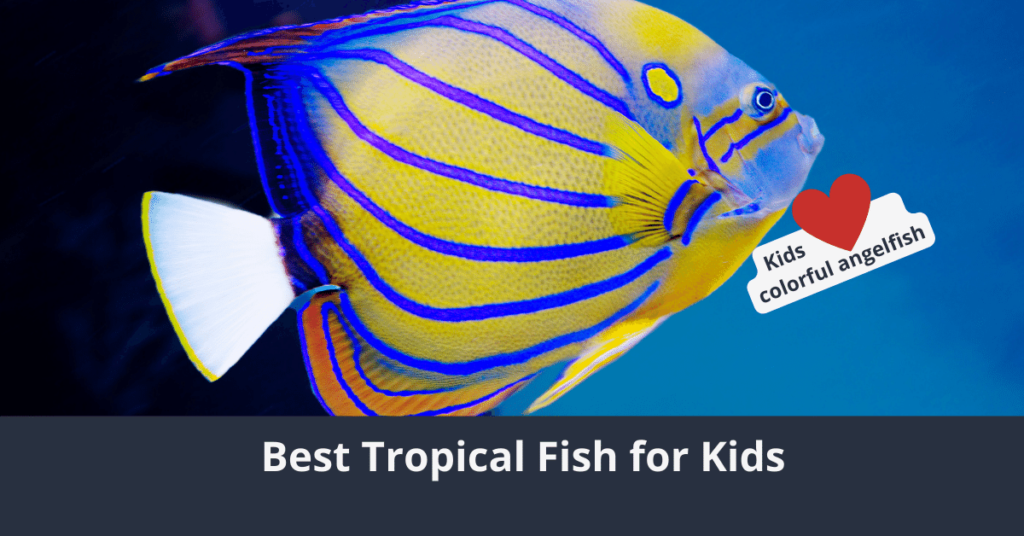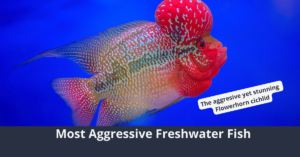While fish continue to be a mainstay for adults, they also are a favorite among kids. However, keeping tropical fish offers challenges for children. Keeping their environment clean and understanding the needs of different species can be tricky.
Yet there are some fish – outlined in our top ten list below – that make it easy to care for and keep kids’ attention over the years.
Everything you will learn here
The 10 Best tropical Fish for kids to rock their world
Tropical fish have been one of the most popular pets for decades. Their hypnotic colors, graceful movements, and exotic living environment continue to fascinate us. Having a tropical fish aquarium provides an exciting way to peer into that mesmerizing world, bringing it right into our home.
We examined many tropical species, taking into account the most important factors in keeping a kid’s interest when maintaining an aquarium. Below are species that offer vibrant colors, exotic looks, interesting movements, and ease of maintenance. They are the best fish for kids.
1. Guppies
They are one of the most common and popular tropical fish, and for a good reason. Guppies come in a beautiful array of colors, from reds to blues and greens. These fish come from South America and can range in size from a half-inch to two and a half inches, with the males displaying beautiful flowing tails.
Guppies are docile, meaning they live well within a community tank. They are also relatively inexpensive compared to other fish. There are many different varieties of this species, and size and tail spans can vary accordingly. Guppies are also a popular species for breeding tanks.
2. Neon Tetras
As the name suggests, the neon tetra is a striking fish with a streak of neon blue and red running horizontally nearly through the entire length of its body. These colors become even more stunning under modern aquarium lighting. It is their stunning appearance that is perfect for kids.
Neons tend to be very active and enjoy socializing. It would be best if you got several of them at once, as they are schooling fish, making them more interesting for viewing. They generally enjoy a water temperature that hovers between 78 and 80 degrees. They are easy to confuse with cardinals, which are not as hardy. The best way to differentiate between the two species is that the neon’s red stripe only runs halfway up their body, while the cardinal goes the full length.
3. Kuhli Loaches
If your kid enjoys the unusual, the kuhli loach is one of the best choices. The eel-shaped fish with the barbels on its head is covered with a beautiful brown and gold striping. According to the USGS, they can grow up to eight centimeters in length. The fish can be very calm, laying still for minutes at a time, and then suddenly burst into a flurry of activity. They are generally very hardy but do require a grainier tank bottom covering as they enjoy burrowing.
Although kuhli loaches are a good community fish, it is best to keep them with other fish that occupy the tank’s top or middle. They will often burrow for their food, and having too many bottom-dwelling fish will force them to compete.
4. Dwarf Gourami
The dwarf gourami makes a list because of its stunning beauty. Its flat half dollar-sized body comes in an array of patterns featuring electric blue and reds. According to the US Fish and Wildlife Service, it can grow up to nine centimeters. They also display an unusual appendage not seen in most other species. It is called a labyrinth organ and is used to breathe at the surface of the water. They are easy to care for and do well in smaller aquariums.
Dwarf gouramis enjoy a water temperature of 78 to 81 degrees. It is important to do regular water changes. Still, no more than 10% of your aquarium’s water at a time as more will cause drastic temperature changes that can result in making them more susceptible to disease.
5. Mollies
For kids interested in starting a breeding tank, the molly is the perfect fish. The black and white speckled species can grow up to two inches in length, and they mate regularly. Still, if you are not interested in breeding, they still make excellent community fish. They do best in groups of four or more as they enjoy socializing with their kind. Their strong bodies that can grow up to four and a half inches long also provide hardiness.
Mollies enjoy temperatures that do not fall below 78 degrees. Even though they enjoy live food such as brine shrimp and worms, they eat dried flake foods. Although most freshwater fish do not do well in salty conditions, mollies can live in slightly brackish waters.
6. Swordtails
If a striking shape catches your child’s eye, then the swordtail is a must. Deriving their name from the male’s long thin extension at the base of their tales, swordtail are an excellent addition to any community aquarium.
Swordtails feature an orange color with a streak of black running along the length of their fin extension. They can grow up to six and a half inches in length, are easy to feed, and are excellent for those interested in keeping a breeding fish.
7. Yoyo Loach
The yoyo loach makes our list because of its big personality. It gets its name from its vertical black markings that form a yoyo pattern. Even though it does not come in a dazzling range of colors, it does make up for that in its mannerisms.
These fish are high energy that enjoy interacting with other species. However, their most popular attributes are their personalities that are so distinctive that they can be individually identified by them, making them popular with kids.
While the yoyo loach will generally mind its own business, it can sometimes get slightly aggressive. If you are planning to introduce them to a community tank, it is recommended that the other species are faster swimmers.
8. Platies
Platies are a favorite among tropical fish enthusiasts and are a great active fish for kids. They come in various colors, ranging from orange to gold, to blue, to a vibrant red. Their tails are often a solid black color. They are also excellent for breeding, as they mate year-round. Their friendly nature makes them good for community aquariums as well.
Platies adjust to a slightly cooler temperature and do not care for the water that is over 77 degrees Fahrenheit. They are tolerant of temperature fluctuations that go as low as 71 degrees. However, sudden changes can result in stress that can be dangerous to their health and result in parasitic infections.
9. Bettas
Also known as Siamese fighting fish, Bettas are one of the most stunning species. They feature vibrant colors that range from deep purple and blue to green and red. If you are looking for the most colorful, the males have large tails and dorsal fins, with a much more striking appearance than their female counterparts.
However, while they are normally fine with community tanks like their name suggests, they will fight other male bettas to the death, so they cannot be with other bettas. Oftentimes, when they see their reflection, they will fan out their tails in a spectacular display.
10. AngelFish
Angelfish are not extremely active. However, they are one of the most interesting of all freshwater species. Their bodies can range in size, going from the circumference of a quarter to half-dollar size. Coloring can vary as well; they usually come in white, silver, black, and gray. Yet their most impressive feature is the size of their fins, which can extend great lengths from their body.
There are several different kinds of angelfish. They can sometimes be aggressive but move slowly, so they generally don’t pose a danger to faster swimmers. They can tolerate water temperatures as low as 78 degrees but prefer a temperature above 81 degrees. They will eat dried flake food; however, they do very well with live food, especially worms.
Honorable Mentions
If none of the above fish has struck your child’s fancy, try the following options. These fish can make excellent additions to an aquarium, and they have special features that can be of particular interest to kids.
- Cory Catfish: Active, hardy, and keeps your tank clean
- Danio: A colorful fish of the tetra family that is good for community aquariums
- Harlequin Rasbora: A grouping tetra with a black, red, and silver coloring
You might also be interested in reading related articles to find more colors:
Final Thoughts
When selecting fish for your child’s aquarium, it is vital to take several factors into account. Make certain they are colorful and active, as these types of fish will hold your child’s interest. Check that the fish you select is easy to take care of. Research their needs. Ensure they do not require complex diets or environments and that small changes do not imperil them.
Above all, go to a tropical fish supplier who is knowledgeable. Check online reviews and learn about the businesses before you patronize them. A tropical fish store with educated staff that can answer all your questions is invaluable and will better your child’s chances of having an enriching experience.



